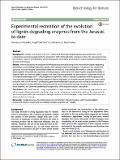Por favor, use este identificador para citar o enlazar a este item:
http://hdl.handle.net/10261/146903COMPARTIR / EXPORTAR:
 SHARE SHARE
 CORE
BASE CORE
BASE
|
|
| Visualizar otros formatos: MARC | Dublin Core | RDF | ORE | MODS | METS | DIDL | DATACITE | |

| Campo DC | Valor | Lengua/Idioma |
|---|---|---|
| dc.contributor.author | Ayuso-Fernández, Iván | - |
| dc.contributor.author | Martínez, Ángel T. | - |
| dc.contributor.author | Ruiz-Dueñas, F. J. | - |
| dc.date.accessioned | 2017-03-16T17:03:05Z | - |
| dc.date.available | 2017-03-16T17:03:05Z | - |
| dc.date.issued | 2017-03-16 | - |
| dc.identifier.citation | Biotechnology for Biofuels 10: 67 (2017) | - |
| dc.identifier.issn | 1754-6834 | - |
| dc.identifier.uri | http://hdl.handle.net/10261/146903 | - |
| dc.description.abstract | [Background] Floudas et al. (Science 336: 1715) established that lignin-degrading fungi appeared at the end of Carboniferous period associated with the production of the first ligninolytic peroxidases. Here, the subsequent evolution of these enzymes in Polyporales, where most wood-rotting fungi are included, is experimentally recreated using genomic information. | - |
| dc.description.abstract | [Results] With this purpose, we analyzed the evolutionary pathway leading to the most efficient lignin-degrading peroxidases characterizing Polyporales species. After sequence reconstruction from 113 genes of ten sequenced genomes, the main enzyme intermediates were resurrected and characterized. Biochemical changes were analyzed together with predicted sequences and structures, to understand how these enzymes acquired the ability to degrade lignin and how this ability changed with time. The most probable first peroxidase in Polyporales would be a manganese peroxidase (Mn3+ oxidizing phenolic lignin) that did not change substantially until the appearance of an exposed tryptophan (oxidizing nonphenolic lignin) originating an ancestral versatile peroxidase. Later, a quick evolution, with loss of the Mn2+-binding site, generated the first lignin peroxidase that evolved to the extant form by improving the catalytic efficiency. Increased stability at acidic pH, which strongly increases the oxidizing power of these enzymes, was observed paralleling the appearance of the exposed catalytic tryptophan. | - |
| dc.description.abstract | [Conclusions] We show how the change in peroxidase catalytic activities meant an evolutionary exploration for more efficient ways of lignin degradation by fungi, a key step for carbon recycling in land ecosystems. The study provides ancestral enzymes with a potential biotechnological interest for the sustainable production of fuels and chemicals in a biomass-based economy. | - |
| dc.description.sponsorship | We acknowledge support of the publication fee by the CSIC Open Access Publication Support Initiative through its Unit of Information Resources for Research (URICI), and the EC OpenAIRE FP7 post-grant Open Access Pilot. | - |
| dc.description.sponsorship | This work was supported by the INDOX (KBBE-2013-613549) and EnzOx2 (H2020-BBI-PPP-2015-2-720297) EU projects and the NOESIS (BIO2014-56388-R) project of the Spanish Ministry of Economy and Competitiveness (MINECO). The work conducted by JGI was supported by the Office of Science of the U.S. Department of Energy under Contract DE-AC02-05CH11231. | - |
| dc.description.sponsorship | EUR 1,620 APC fee funded by the EC FP7 Post-Grant Open Access Pilot | - |
| dc.publisher | BioMed Central | - |
| dc.relation | FP7 post-grant Gold Open Access Pilot | - |
| dc.relation | info:eu-repo/grantAgreement/EC/FP7/613549 | - |
| dc.relation | info:eu-repo/grantAgreement/EC/H2020/720297 | - |
| dc.relation | info:eu-repo/grantAgreement/MINECO/Plan Estatal de Investigación Científica y Técnica y de Innovación 2013-2016/BIO2014-56388-R | - |
| dc.relation.isversionof | Publisher's version | - |
| dc.rights | openAccess | - |
| dc.subject | Lignin biodegradation resurrected enzymes | - |
| dc.subject | Catalytic properties | - |
| dc.subject | pH stability | - |
| dc.subject | Ligninolytic peroxidases | - |
| dc.subject | Ancestral sequence reconstruction | - |
| dc.subject | Fungal evolution | - |
| dc.subject | Fungal genomes | - |
| dc.title | Experimental recreation of the evolution of lignin-degrading enzymes from the Jurassic to date | - |
| dc.type | artículo | - |
| dc.identifier.doi | 10.1186/s13068-017-0744-x | - |
| dc.relation.publisherversion | http://dx.doi.org/10.1186/s13068-017-0744-x | - |
| dc.date.updated | 2017-03-16T17:03:06Z | - |
| dc.language.rfc3066 | en | - |
| dc.rights.holder | The Author(s) | - |
| dc.rights.license | http://creativecommons.org/licenses/by/4.0/ | - |
| dc.contributor.funder | European Commission | - |
| dc.contributor.funder | Ministerio de Economía y Competitividad (España) | - |
| dc.contributor.funder | Department of Energy (US) | - |
| dc.relation.csic | Sí | - |
| dc.identifier.funder | http://dx.doi.org/10.13039/501100000780 | es_ES |
| dc.identifier.funder | http://dx.doi.org/10.13039/501100003329 | es_ES |
| dc.identifier.funder | http://dx.doi.org/10.13039/100000015 | es_ES |
| dc.identifier.pmid | 28331543 | - |
| dc.type.coar | http://purl.org/coar/resource_type/c_6501 | es_ES |
| item.openairetype | artículo | - |
| item.grantfulltext | open | - |
| item.cerifentitytype | Publications | - |
| item.openairecristype | http://purl.org/coar/resource_type/c_18cf | - |
| item.fulltext | With Fulltext | - |
| Aparece en las colecciones: | (CIB) Artículos | |
Ficheros en este ítem:
| Fichero | Descripción | Tamaño | Formato | |
|---|---|---|---|---|
| 13068_2017_Article_744.pdf | 2,68 MB | Adobe PDF |  Visualizar/Abrir |
CORE Recommender
PubMed Central
Citations
21
checked on 05-abr-2024
SCOPUSTM
Citations
37
checked on 20-abr-2024
WEB OF SCIENCETM
Citations
30
checked on 26-feb-2024
Page view(s)
307
checked on 22-abr-2024
Download(s)
246
checked on 22-abr-2024

